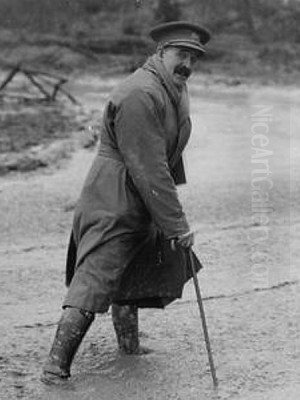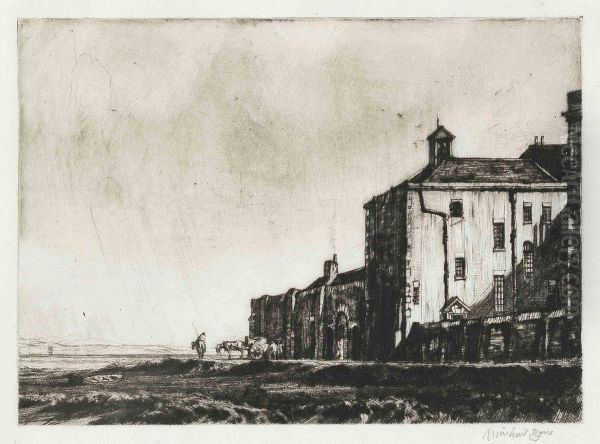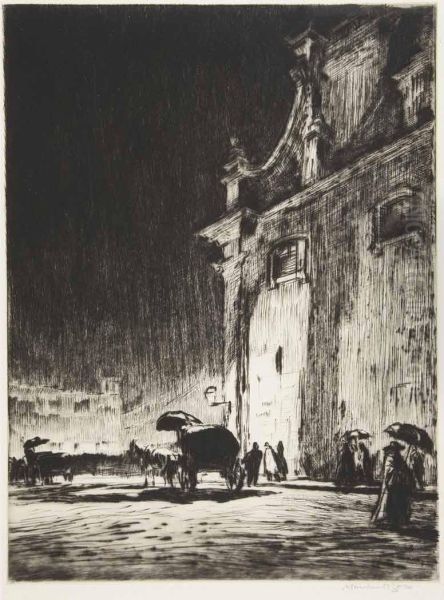Introduction: A Scottish Master Emerges

Sir Muirhead Bone (1876–1953) stands as a significant figure in early 20th-century British art, celebrated primarily for his exceptional skills as an etcher, drypoint artist, lithographer, and draughtsman. Born in Partick, a suburb of Glasgow, Scotland, Bone initially embarked on a path towards architecture. However, his innate artistic inclinations soon led him away from building design and towards the expressive possibilities of printmaking and painting, fields where he would achieve international renown. His work is characterized by meticulous detail, a profound understanding of structure, and a remarkable ability to capture atmosphere, whether depicting grand architectural vistas, the industrial might of shipyards, or the stark realities of modern warfare.
Early Life and Artistic Formation in Glasgow and London
Muirhead Bone's artistic journey began in his native Glasgow. Born on March 23, 1876, he initially trained as an architect's apprentice, an experience that undoubtedly honed his eye for structural detail and perspective, qualities that would become hallmarks of his later work. Concurrently, he attended evening classes at the Glasgow School of Art starting around 1897. It was here, and through exposure to the works of masters, that his passion for the graphic arts ignited. He began experimenting with printmaking, particularly etching and drypoint, around 1898. His early efforts showed promise, influenced by the rich tradition of architectural etching exemplified by artists like the French master Charles Meryon and perhaps the dramatic perspectives of Giovanni Battista Piranesi.
Feeling the pull of the larger art world, Bone moved to London in 1901. This move proved pivotal. He quickly connected with the progressive art scene, becoming a member of the influential New English Art Club (NEAC), a society that included prominent artists like Walter Sickert and Philip Wilson Steer, known for challenging the conservative norms of the Royal Academy. In 1902, Bone held his first solo exhibition at the Carfax Gallery in London. The show was a critical and commercial success, rapidly establishing his reputation as a formidable new talent in the demanding medium of printmaking.
Mastery of Etching and Drypoint

While proficient in various media, including watercolour and lithography, Bone's most enduring legacy lies in his mastery of etching and, particularly, drypoint. Drypoint, a technique where the artist incises directly into the copper plate using a sharp needle, creates a raised ridge of metal called a 'burr' alongside the incised line. When inked, this burr holds extra ink, producing characteristically rich, velvety lines that lend a unique depth and texture to the print. Bone exploited the possibilities of drypoint with extraordinary skill, achieving subtle tonal variations and intricate detail that few could rival.
His early works often focused on architectural subjects, particularly scenes of construction and demolition, capturing the dynamic transformation of the urban landscape. A standout example is The Demolition of St. James's Hall (1905). This series of prints documents the dismantling of a famous London concert hall, transforming a scene of destruction into a complex, almost beautiful study of structure, scaffolding, light, and shadow. His keen architectural sense, inherited from his early training, allowed him to render complex structures with accuracy and dramatic flair.
Other significant works from this early period include Ayr Prison (1905), showcasing his ability to imbue even stark subjects with atmospheric depth, and Rainy Night in Rome (1905), which demonstrates his skill in capturing fleeting effects of weather and light within an urban setting. His detailed cityscapes invited comparisons with earlier masters of the urban view, such as Canaletto, while his technical virtuosity in drypoint placed him in the lineage of printmaking giants like Rembrandt and James McNeill Whistler, helping to revitalize interest in the technique during the British Etching Revival.
The First Official War Artist: Chronicling the Western Front
The outbreak of the First World War dramatically shifted the focus of Bone's work. In May 1916, he received a unique and historic appointment: he became Britain's first official war artist, commissioned by the government under the auspices of the War Propaganda Bureau (later the Ministry of Information). Sent to the Western Front, his task was to create a visual record of the war, intended both for propaganda purposes and as a historical document.
Attached initially to the British forces during the Battle of the Somme, Bone produced an astonishing volume of work – over 150 drawings in just a few months. Unlike some contemporaries who focused on the dramatic horror of battle, Bone, while not shying away from the devastation, often concentrated on the broader context of the war: the immense logistical effort, the lives of the soldiers behind the lines, the ruined landscapes of France and Flanders, and the machinery of war. He possessed an uncanny ability to find structure and composition even amidst chaos and destruction.

His drawings, often executed in pencil, charcoal, and wash, were characterized by their precision and documentary clarity, yet they retained a powerful emotional resonance. They were widely disseminated through official publications, most notably The Western Front, a serial publication featuring Bone's drawings with accompanying text. This work brought the realities of the war, filtered through Bone's observant eye, to the British public. His role placed him alongside other significant artists documenting the conflict, including Paul Nash, C.R.W. Nevinson, Wyndham Lewis, William Orpen, and Augustus John, each offering their unique perspective on the unprecedented global conflict.
Interwar Years: Travel, Recognition, and Institutional Roles
After the armistice, Muirhead Bone returned to his established themes but also explored new subjects, informed by his wartime experiences and subsequent travels. He continued to produce masterful prints of architectural and industrial scenes. His reputation, already high before the war, was now cemented as one of Britain's leading graphic artists.
He travelled extensively, including trips to Spain, which resulted in notable works capturing the country's landscapes and architecture. One significant project was Old and New Spain, featuring prints that contrasted traditional scenes with modern developments. A particularly interesting work from this period is the colour lithograph Puente Nuevo, Ronda (c. 1936), depicting the famous bridge in Ronda, a project he reportedly collaborated on with his brother, the journalist and author James Bone, showcasing his versatility across different printmaking techniques.
Recognition continued to accrue. He remained an active member of artistic societies, including the International Society of Twelve, a group primarily of Scottish artists including fellow etcher D.Y. Cameron. His work was regularly exhibited, including at the Royal Academy. A significant honour came in 1937 when he was knighted for his services to art. Furthermore, his connection to the documentation of war led to his appointment as a Trustee of the newly formed Imperial War Museum in 1920, a position he held for many years, helping shape the institution dedicated to preserving the memory of the conflict he had so meticulously recorded. He remained a prominent figure, alongside other established printmakers of the era like Gerald Brockhurst and Edmund Blampied.
The Second World War: A Return to Service
With the outbreak of the Second World War in 1939, Sir Muirhead Bone, despite being in his sixties, once again offered his services. He was appointed an official war artist for a second time, this time attached to the Admiralty. He also became a key member of the War Artists' Advisory Committee (WAAC), chaired by Sir Kenneth Clark, which oversaw the commissioning of artists during the conflict.
His focus during this war shifted largely towards maritime subjects: the activities of the Royal Navy, shipbuilding efforts, convoy duties, and coastal defences. He held the rank of Honorary Major in the Royal Marines and later Honorary Commodore in the Royal Naval Volunteer Reserve. His works from this period often reflect the vast scale of the naval war effort. One notable large-scale drawing is Winter Mine-Laying off Iceland, capturing the harsh conditions and perilous work undertaken by naval crews.
His contributions during WWII placed him among a new generation of war artists commissioned by the WAAC, including talents like Eric Ravilious, Laura Knight, Stanley Spencer, and Henry Moore. Bone's work provided a crucial link between the artistic documentation of both world wars, bringing his established skills and reputation to bear on recording a new global conflict. He continued working actively throughout the war and into the post-war years, eventually passing away in Oxford on October 21, 1953.
Artistic Style and Enduring Themes
Sir Muirhead Bone's artistic style is defined by its remarkable synthesis of technical precision and atmospheric sensitivity. His background in architecture provided a foundation for his convincing depictions of complex structures, whether ancient cathedrals, bustling city streets, intricate scaffolding, or the powerful forms of warships and industrial machinery. He possessed an almost unparalleled mastery of line, particularly evident in his drypoints, where the rich burr added texture and depth to his compositions.
While fundamentally a realist, committed to accurate observation, his work often carries a romantic undercurrent. He found beauty and drama in unexpected places – the skeletal remains of a demolished building, the intricate patterns of shipyard cranes, the desolate landscapes of the Western Front. He excelled at capturing light and atmosphere, using subtle tonal gradations to evoke mood, whether the gloom of a rainy night, the starkness of a battlefield, or the hazy light of an industrial cityscape.
His primary themes remained consistent throughout his career: architecture in all its forms (grandeur, construction, decay), the power and scale of modern industry (particularly shipbuilding), landscapes (both urban and rural), and the impact of war on people and places. He stands as a key figure in the British Etching Revival, not only for his technical brilliance but for his dedication to drypoint and his ability to apply traditional techniques to thoroughly modern subjects. His influence can perhaps be seen in later British artists who combined topographical accuracy with expressive line, such as Graham Sutherland, another notable war artist and printmaker.
Legacy and Collections
Sir Muirhead Bone enjoyed considerable acclaim during his lifetime and remains highly regarded for his contributions to British printmaking and war art. His legacy is twofold: he was an artist of exceptional technical skill who pushed the boundaries of etching and drypoint, and he was a vital chronicler of his time, capturing moments of profound historical significance with clarity and artistry. His war drawings, in particular, constitute an invaluable historical record, offering a unique and human perspective on the cataclysms of the early 20th century.
His works are held in major public collections around the world, testifying to his enduring importance. In the United Kingdom, significant holdings can be found at the British Museum, the Tate Gallery, the Imperial War Museum (which holds the bulk of his official war art), the National Gallery, London, and the National Galleries of Scotland. These collections preserve the vast output of a prolific and dedicated artist whose meticulous eye and skilled hand documented the changing face of Britain and the stark realities of modern conflict for future generations.
Conclusion: A Singular Vision
Sir Muirhead Bone carved a unique path through British art history. From his beginnings in architectural training to his emergence as a leading printmaker and his crucial role as an official war artist in two world wars, his career was marked by technical brilliance, keen observation, and a profound engagement with the defining events and environments of his era. His masterful drypoints of architecture and industry, alongside his poignant and detailed records of war, secure his place as a significant Scottish and British artist. He was more than just a skilled technician; he was a visual historian whose work continues to resonate with its blend of documentary accuracy and artistic power.